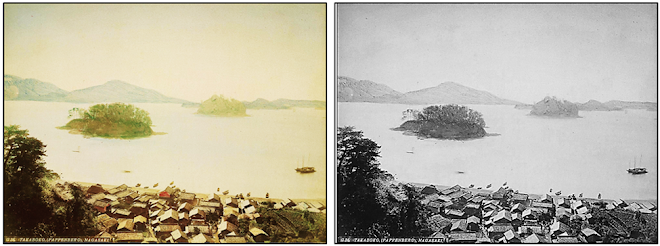NAGASAKI - JAPAN
KOBE, KYOTO, OTSU, KIGA
1892-1895 WORLD TOUR OF GEORGE BULLOUGH
1892-1895 WORLD TOUR OF GEORGE BULLOUGH
Descriptive text
relates to period of visit, i.e. early 1890’s unless otherwise stated.
BLOG 86 - ALBUM
XVII * Photographs 20 - 30
Photographs collected by
George Bullough, (later Sir George, Baronet)
and his travelling companion, Robert
Mitchell during their 1892-1895 Grand World Tour and mounted
in twenty albums in the library
at Kinloch Castle.
Regrettably
Kinloch Castle Library, on the south-west (ground floor) corner has
two external walls and suffers from high humidity and constant ingress of damp.
two external walls and suffers from high humidity and constant ingress of damp.
The room has also
suffered at least one inundation of water through the ceiling
from an
overflowing sink in the bathroom two floors above.
“It is crucial
to store books and photographs correctly, to respect their age and
vulnerability to thoughtless
handling. This is especially true for hand-coloured prints as the colours were only
applied to the surface of the photograph, never becoming an actual part of the resulting
image. Therefore the delicate surface is prone to scratching, blurring, loss of colour
and crinkling due to high humidity.”
Sadly this is
all too apparent in several of the photographs, particularly Images 20,
21
depicting Takaboko... and Pappenberg Rock ... ... ...
G40 TAKABOKO (PAPPENBERG) NAGASAKI
Original photograph
by Tamamura Kôzaburô
Album XVII * Image 20 * Size original photograph 11 x 8¼ inches |
| The island of Takaboko at the inlet entrance to Nagasaki harbour. (From Image 23) |
Four hundred years ago the heavily wooded picturesque island of Takaboko-shima was the scene of a “fearful tragedy.”
Renamed Pappenberg - Dutch for Catholic Mountain - by
Western tour guides in the 1860’s it lies at the very seaway entrance to the harbour of Nagasaki on the southern
Japanese island of Kyushu.
Western tour guides in the 1860’s it lies at the very seaway entrance to the harbour of Nagasaki on the southern
Japanese island of Kyushu.
In 1620 the Tokugawa Shogunate (Japanese rulers) having become alarmed at the rapid spread of Catholicism following the arrival of a mission of Jesuits led by forty-three year old Francis Xavier in July 1549 banned Christianity.
O’HATO, NAGASAKI  |
G54 O’HATO, NAGASAKI
|
G54 O’HATO, NAGASAKI
Album XVII * Image 22 * Detail from full size 10¾ x 8½ inches.*****+++++*****+++++***** *****+++++*****+++++*****

M2 PAPENBERG ROCK
Album XVII * Image 23 * Size 9½
x 7½ inches*****+++++*****+++++***** *****+++++*****+++++*****
*****+++++*****+++++***** *****+++++*****+++++*****
*****+++++*****+++++***** *****+++++*****+++++*****
 |
KOBE
Album XVII *
Image 25 * Size 11½ x 8½ inches. |
 |
| KOBE Album XVII * Image 25 * Detail from full size 11½ x 8½ inches |
*****+++++*****+++++***** *****+++++*****+++++*****
THE BUND (KOBE)
 |
| F72 THE YAAMI Album XVII * Image 27 * Detail from full size 9½ x 7½ inches |
An anecdote connected to Kipling's visit recalls “he was woken on his first morning by the booming of a great bell* … twenty feet of green bronze hung inside a fantastically roofed shed of wooden beams.”
The bell, which is still rung, requires seventeen monks each holding a rope connected to a sixteen foot long pole which is swung too and fro until with a final leap the monk in the white habit directs the swinging beam into the bell - BOOM!
* The 74 ton Chionin Bell was cast in 1633.
Regrettably the Yaami Hotel was destroyed by fire in 1906.

*****+++++*****+++++***** *****+++++*****+++++*****
WATERFALL KINGIYO TEA HOUSE AT KIGA
WATERFALL KINGIYO TEA HOUSE AT KIGA
Album XVII * Image 28 * Size 11 x 8½ inches
Reference; “Japan: Travels and Research”
by Professor Johann J. Rein – Published 1884. (Page 48)
*****+++++*****+++++***** *****+++++*****+++++*****


F41 RAPIDS NEAR KYOTO (Hozugawa River)
Album XVII * Image 29 * Size of original 9½ x 7½ inches.
Hozugawa River, today a popular tourist destination where
professional boatmen
take those daring enough to “run the rapids”.
F41 RAPIDS NEAR KYOTO (Hozugawa River)
Album XVII * Image 29 * Detail from full size of original 9½ x 7½ inches.
Album XVII * Image 30 * Size 11 x 8½ inches
 Today Otsu, meaning “big port”, with a population
approaching 350,000, is capital city of Shiga Prefecture.
Today Otsu, meaning “big port”, with a population
approaching 350,000, is capital city of Shiga Prefecture. It is a port on Japan’s largest freshwater lake, 260 square mile Lake Biwa, which for centuries has been a centre for water borne commerce.
In the 1890’s a 5½ mile long canal was constructed
between Otsu and Kyoto to more speedily facilitate shipments of freight and increasing passenger traffic,
it also supplied water to Japan’s first public hydroelectric power generator
which powered Kyoto’s trams.
*****+++++*****+++++*****
END OF ALBUM XVII
Text personally researched and written by George W. Randall
Photographs from my archived copies of the originals in the library at Kinloch Castle.
REVIEWED AND UPDATED BY THE AUTHOR 18 JUNE 2025
George W. Randall Research Archive













































No comments:
Post a Comment